Tips For Snagging a Permit for The John Muir Trail
It's that time of year folks: it's time to get your hiking permits for this summer.
And with the John Muir Trail being one of the (if not the) premier long distance trails in the United States, permits are understandably tough to get. The process can also be very confusing if you're new to it, which can hinder your chances even more.
In this post I'll be covering the ins and outs of getting a soutbound JMT permit in 2020 (the northbound process is entirely different), including where and when to start, how and when to apply, and all the other technical aspects of applying. I'll also share with you a couple little things you can do to significantly increase your odds of snagging one of these elusive permits.
(Want to go on an epic backpacking trip like the JMT, but don't know where to start? Check out our Wilderness Backpacking For Beginner's post series. It'll give you everything you need to know to get out there.)
Understanding the John Muir Trail Permit System
Southbound John Muir Trail permits are issued by Yosemite National Park on a per-day quota system. It is technically an exit quota, counting the number of hikers that will exit the park over Donohue Pass, and the daily allotment is 45 total hikers. These 45 are spread across 5 trailheads, but they are not spread evenly.
- 20 are reserved for both Happy Isles trailheads, Glacier Point, and Sunrise Lakes
- 15 are reserved for Lyell Canyon
- 10 are reserved for same day walk-up permits from Lyell Canyon
This means that of the 35 available for advance reservation, nearly half of them are for Lyell Canyon. I'll go over how this could help you once I get into trailhead details.
When should I apply?
The permit lottery for a given start date is always 168 days in advance of that date. It used to be that you had to fax in a written permit the day before or the day of, but with the new online system you can submit your permit up to 2 days before the lottery, or 170 days in advance.
You can use this chart provided by Yosemite NP to help you determine when you need to apply.
How do I apply?
You used to have to send a fax for every day you wanted to enter, but now you can submit one online application for a date range of up to 21 days. This means that you can choose your earliest possible start date and continue applying each day automatically. If you don't receive a permit, your application automatically rolls to the next day. If you do, your application will be removed from the pool.
How much does it cost?
Granted permit requests cost $5 per transaction and an additional $5 per person on the permit. That comes out to $15 for two people, or $25 for four four people.
Half-dome permits can be added to your itinerary for an additional $10 per person as well.
Filling Out Your Online Application
Here's where things can get tricky. I'm going to do a full step-by-step walkthrough here to make it as easy as possible for you to make the necessary decisions and submit a valid application.
1. Choose a Starting Trailhead
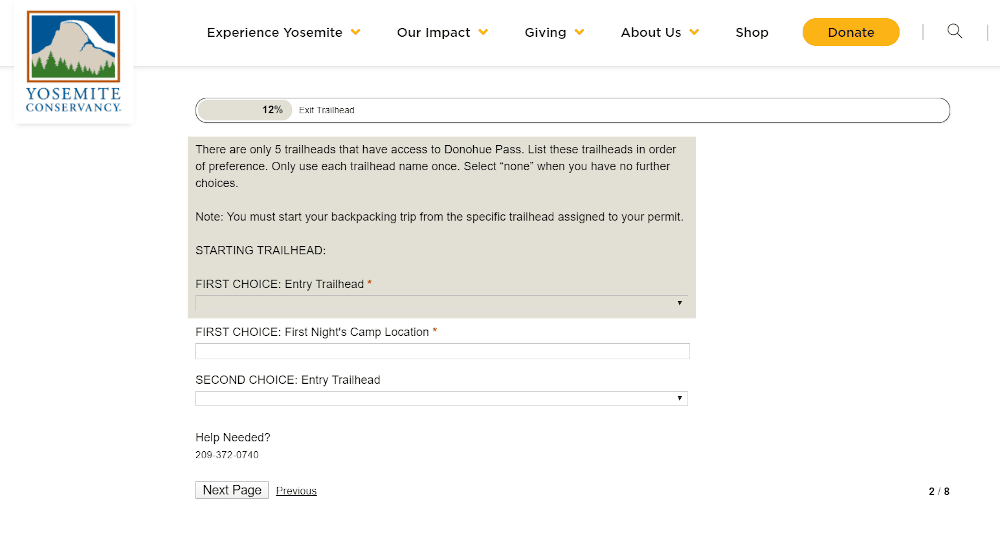
As I noted above, there are 5 trailhead options to choose from. They are:
- Happy Isles>Little Yosemite Valley
- Happy Isles>Sunrise/Merced Lake(pass through Little Yosemite Valley)
- Glacier Point>Little Yosemite Valley
- Sunrise Lakes
- Lyell Canyon
You should use the Yosemite NP trailhead map to familiarize yourself with where each of these are and how they relate to the JMT. I'll describe them in detail but it helps a lot to have a mental picture of where each one is.
It's also important to note that the first nights camp location is really for verifying that you understand where you are allowed to camp with a permit for that trailhead. You aren't required to camp exactly where you state your first nights camp to be (With the exception of Little Yosemite Valley), just nearby and within the parameters for that particular trailhead.
1. Happy Isles>Little Yosemite Valley
The traditional start of the JMT is at Happy Isles, and it is therefore the most popular starting option. With this option, you must camp in Little Yosemite Valley on your first night. It is traditional and it's a cool experience, but this limits your first hiking day to about 5 miles. Adding a trip to Half Dome does help this a little, though.
First nights camp location: Little Yosemite Valley
2. Happy Isles>Sunrise/Merced Lake
With this option you still start at Happy Isles, but you must pass through LYV and continue "in the direction of either Merced Lake or Sunrise High Sierra Camp." I like this better, and if hiking the traditional JMT is important to you, I would choose this option as your first choice. Hiking Half Dome is also still a good option from this trailhead.
First nights camp location: Sunrise High Sierra Camp
3. Glacier Point>Little Yosemite Valley
This trailhead starts you at Glacier Point and you'll join the JMT at Little Yosemite Valley. I really don't see any advantage to this option aside from starting off downhill instead of uphill. It's harder to get to, it's not the true start of the JMT, and it doesn't give you a higher chance of getting a permit because it is part of the pool of 20.
First nights camp location: Little Yosemite Valley
4. Sunrise Lakes
This option isn't too bad if you want to start further along, especially if you're okay with doing the first section as day hikes. The campsites won't be quite as crowded and getting to the trailhead from Tuolomne Meadows is easy. I still don't think it's that great, though, and Half Dome isn't really an option. This option also doesn't help your odds at all, so I wouldn't consider it high priority.
First nights camp location: Cathedral Lakes area
5. Lyell Canyon
While not the traditional start of the JMT, this is a great option because so few people want it. By far most people prefer the classic starting points and I'm sure they generally go first in the lottery, but there are nearly as many slots from Lyell Canyon as there are from the other 4 trailheads together. This means that if you place it as priority 1, you'll likely have a much better chance of securing a permit for your desired group size. (If your highest priority is your desired trailhead regardless of how group size, then this won't help you very much.) It's also very easy to access, and the trailhead is right next to the wilderness center where you can pick up your permit. Half Dome is definitely not an option from this trailhead, however.
First nights camp location: Lyell Fork
*Hot tip: We got our 2019 JMT permits for Lyell Canyon with it placed as our second choice, but if I was to do it again I would just put Lyell Canyon as number one. If you want the true JMT experience you could day hike from Happy Isles and camp at the Tuolomne backpackers campground the night before your permit starts (your permit allows one night in a backpackers campground on either side of your itinerary). Then start from Lyell Canyon in the morning. We didn't do it because of time constraints, but I wish we would have. If you'd prefer to start on day one from Happy Isles, then I'd go with the Happy Isles/Merced Lake option for reasons listed above, and set Lyell Canyon as number 2. Unless you have a pretty specific reason for choosing one of the other 3, they really don't have many advantages.
2. Exit Trailhead
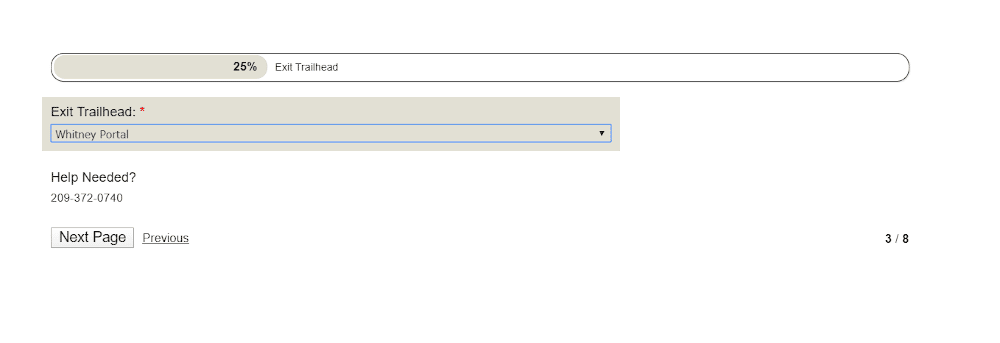
For everyone planning to hike the entire John Muir Trail, you will choose Whitney Portal as your exit trailhead. There are other options, but I'm assuming here that if you need one of those you probably know which one it is already.
3. Date Range
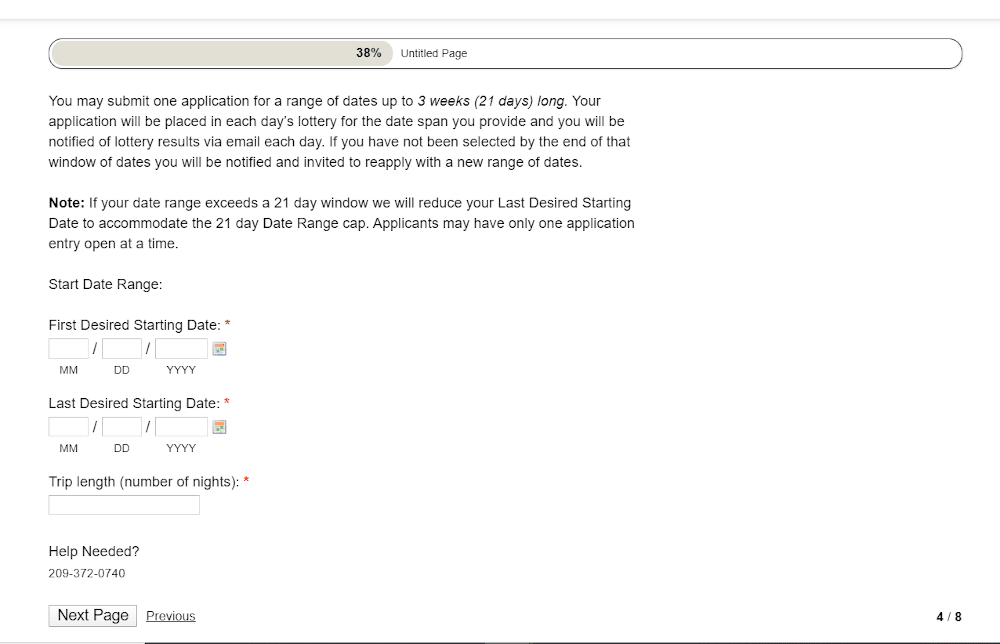
Peak hiking season in the Sierra is July-August, so naturally the highest competition for permits will be during that time. There is good reason for that, but if you're okay with a little compromise then trying for the shoulder seasons should give you a better chance of securing a permit. Just be aware that early season (May-June) can mean a lot of snow depending on the year, and late season (September-October) can mean inclement weather and lower temperatures. On the flip-side, sometimes June can be as good as July and September can be the most beautiful time to be in the mountains. As always, know your own abilities and limits well and be prepared for worst case scenarios.
To get the most out of your application, you should definitely use the whole 21 day range if you can. I recommend setting your first desired starting date a little earlier than your "ideal" start date and extending the the date range as far as you are able to.
As far as trip length, you can set it at whatever you want and it won't affect your permit. You won't get in trouble for finishing early, but if you're on trail after your permits end date then you could get a fine. I would set it 5-6 days longer than you think you'll need just to be safe.
4. Group Size
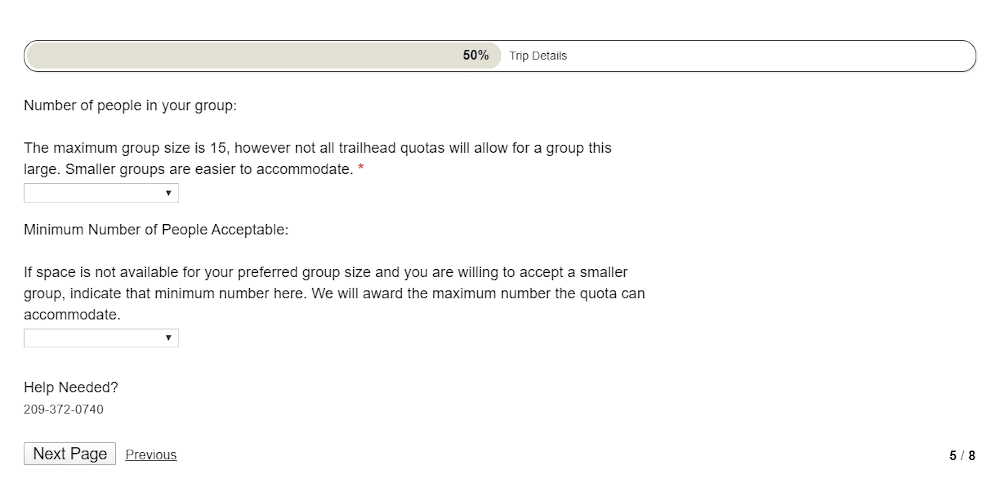
This page has two parts; number of people in your group and minimum number acceptable. For the first you can put whatever number of people is your ideal group size. But remember, you must all travel together during the entire trip because you only get one permit per group. For this reason it may be better for some groups to try to get separate permits.
For the second, put your absolute minimum number of people you could get a permit for and still want to go. The lower the number the more likely you are to actually get it. For the best odds this number should be 1, but putting 2 should still give you a pretty good chance.
5. Half Dome Permits
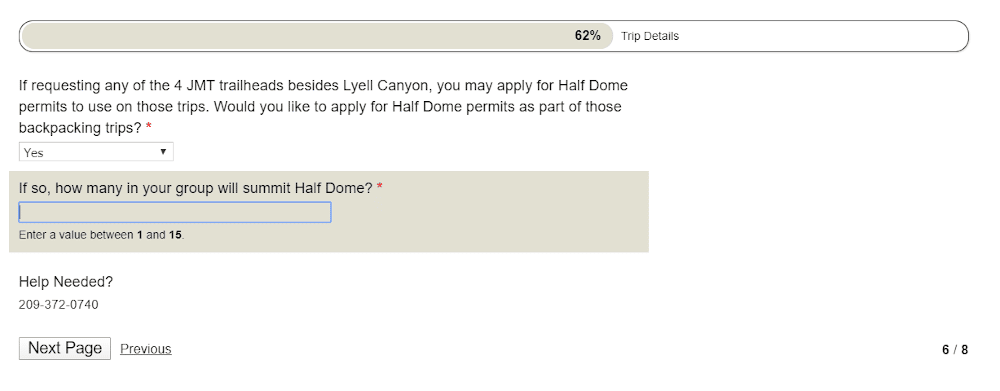
We didn't do Half Dome because our permits were for Lyell Canyon, but I definitely would have if we had started from Glacier Point or Yosemite Valley. From Sunrise Lakes it's technically an option, but requires backtracking downhill which for most people isn't ideal.
Half Dome permits are not day-hike permits and are not guaranteed with a JMT permit, but if you choose yes you will be entered in the lottery for these as well. It won't affect your chances in the general JMT lottery either, as they are separate lotteries. Half Dome permits are an additional $10 per person.
6. Guided/With Stock
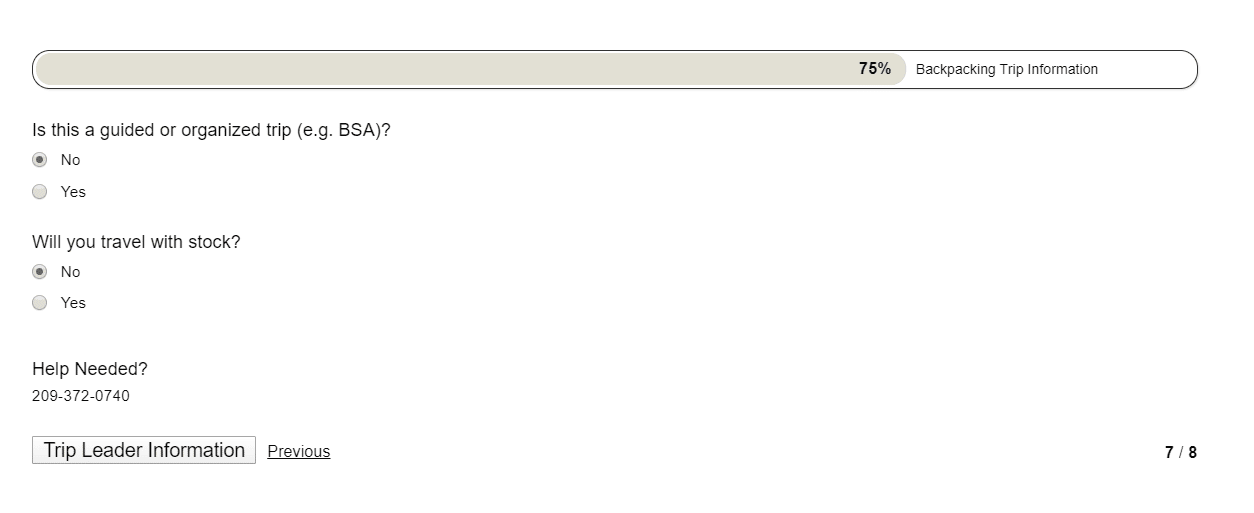
If you need to answer yes to either of these options, you'll know. Most people will put 'no' for both.
7. Trip Leader Info
The last page is just contact info for the trip leader. This is the only person named on the permit and must be present for the whole trip, so make sure that if you aren't the trip leader that you get the info of whoever will be. Photo ID is required when you pick up your permit.
Best practices for increasing your odds
Basically there are four big things you can do to significantly increase your chances of snagging your desired permit. They are:
- Place Lyell Canyon as first priority trailhead choice
- Apply for shoulder season dates if possible
- Use the full date range and keep applying as long as you can
- Make your minimum number of people acceptable 1-2
It's hard to tell how much these tips will help, but every little bit helps in a permit process as competitive as this one.
*A word on submitting multiple applications*:The Yosemite National park website is very clear regarding duplicate entries. It asks that you submit only one application for the same group, and that duplicate entries will not be considered. This is apparently to make the process less competitive, although it completely relies on the honor system to do so.
I'm not going to give advice on this one way or the other. I will say, however, that because the system is not sophisticated enough to weed out duplicate applications under different trip leader names, tons of people will certainly be doing it. Not doing it puts you at a disadvantage no matter what. I think that ultimately the decision to do it or not comes down to personal ethics. Keep in mind when making this decision that if you do get more than one permit and don't use both, that's a permit someone else could have received through the lottery system (though that spot will almost certainly still be reserved later). Also photo ID is required to pick up a permit, so submitting random names and e-mail addresses will do you no good.
I've done as much reading on this as I could find, and it seems people are split pretty evenly on whether it's okay or not. It's a bit of an ethical conundrum and I honestly still haven't decided for myself what I think is "right" here. This part is up to you.
After You Complete Your Application..
Sit around and wait as patiently as you can for a response! On the application dates chart you can also see when drawings are for a given start date (if you're as obsessive as I am). You'll get an e-mail on the day your application is processed stating whether your permit request has been granted. If it was denied, your request will roll over to the next day until you receive a reservation or your date range runs out. If your date range does run out, you can submit another application for another 21 days starting the next day, if you want.
If your permit request is granted, congrats! Just remember that you need to pay for your permit within 14 days of receiving a granted reservation request. You will also need to pick up your permit in person the day of or day before your trip starts at a Yosemite Ranger station or wilderness center.
After paying for your permit, it's time to get planning! Another logistical challenge is deciding on a resupply strategy, so check out our post on it; Guide To Resupply on the John Muir Trail.

Hi Brady. First of all, this is the most helpful blog that I’ve come across yet. So much great information – especially for an aspiring first time JMT hiker like myself. I have a general question that I can’t seem to find an answer to. What is the benefit of prioritizing starting trailheads? I am under the assumption that if my application is picked, they will go down the list of my 5 preferred starting locations. If Happy Isles is full, they’ll go to the next one, so on and so forth. How does placing Lyell Canyon closer to the top of my list increase my chances. If it is my 5th choice, wouldn’t they get to it if my other four choices are taken? I hope this makes sense! In summary, if my application “wins” the lottery, availability at any of my five choices (according to availability and prioritization) should get me in, correct?
Hey Chris, thanks for the support! In all my reading on this I’ve never been able to find out definitively how they do the lottery. The way you outlined certainly makes the most sense and is what I would assume they do, but without an inside source it’s hard to tell. Aside from the slight possibility of a hidden benefit (maybe some kind of weird allotment system for the 4 non-Lyell Canyon trailheads), the biggest benefit I see is actually getting your desired number of hikers. Based on what I’ve seen Lyell Canyon is by far the least desirable trailhead, and by this and probability alone it’s 15 slots should fill slower than the rest. Therefore it will likely have more slots available when the other trailheads are down to just a few. So in a scenario where your ideal number of hikers is 4 but your minimum is 2, if Happy Isles is your first priority and there are only 2 spots left there I assume you would be awarded a 2-person Happy Isles reservation even if there are 4+ slots still available at Lyell Canyon. By setting Lyell Canyon as first priority, you should be increasing your chance of getting your ideal number of hikers. Of course in practice this could flip on you, but I think the probabilities lean pretty solidly in favor of it working most of the time. Granted, this doesn’t help someone who is only applying for 1 person or whose minimum is the same number as their ideal, and if ideal trailhead is more important to you than ideal group size it doesn’t help either. Overall prioritizing Lyell Canyon is more about group size than anything, but that’s definitely not clear in the post so I think I’ll update it to reflect that. Thanks for raising a good point.